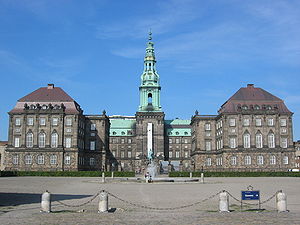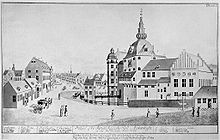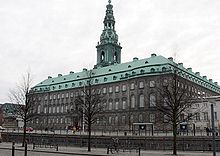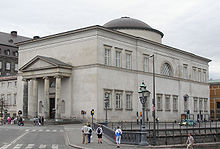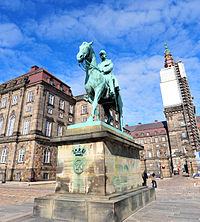- Christiansborg Palace
-
For the castle in Ghana known as Fort Christiansborg, see Osu Castle.
Christiansborg Palace Christiansborg Slot 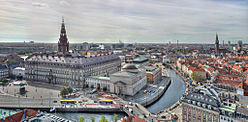
Christiansborg Palace from aboveGeneral information Architectural style Baroque, Neoclassicism, Neo-baroque Town or city Copenhagen Country Denmark Construction started 1733 Completed 1928 Design and construction Architect Elias David Häusser, Christian Frederik Hansen, Thorvald Jørgensen Christiansborg Palace, Danish pronunciation: [krɪsdjænsˈbɔːɐ̯ˀ], on the islet of Slotsholmen in central Copenhagen, is the seat of the Folketing (the Danish parliament), the Danish Prime Minister's Office and the Danish Supreme Court. Also, several parts of the palace are used by the monarchy, including the Royal Reception Rooms, the palace chapel and the royal stables.
The palace is thus the house of Denmark's three supreme powers: the executive power, the legislative power, and the judicial power. It is the only building in the world that houses all three of a country's branches of government. Christiansborg Palace is owned by the Danish state, and is run by the Palaces and Properties Agency.
The present building is the last in a series of successive castles and palaces constructed on the same site since the erection of the first castle in 1167. Since the early fifteenth century, the various buildings have served as the base of the central administration; until 1794 as the principal residence of the Danish kings and after 1849 as the seat of parliament.
The palace today bears witness to three eras of Danish architecture, as the result of two serious fires. The first fire occurred in 1794 and the second in 1884. The main part of the current palace, finished in 1928, is in the historicist Neo-baroque style. The chapel dates to 1826 and is in a neoclassical style. The showgrounds were built 1738-46, in a baroque style.
Contents
History
Absalon's Castle
Main article: Absalon's CastleThe first castle on the site was Absalon's Castle. According to the Danish chronicler Saxo Grammaticus, Bishop Absalon of Roskilde built a castle in 1167 on a small island outside Copenhagen Harbour. The castle was made up by a curtain wall, encircling an enclosed courtyard with several buildings, such as the bishop's palace, a chapel and several minor buildings. The ruins of Absalon's Castle can be seen today in the subterranean excavations under the present palace and show how the castle's owners developed and renewed the castle.
At the death of Absalon in 1201, possession of the castle and city of Copenhagen passed to the bishops of Roskilde. A few decades later, however, a bitter feud erupted between crown and church, and for almost two centuries the ownership of the castle was heavily contented between kings and bishops. Furthermore, the castle was frequently under attack, for example by Wend pirates and the Hanseatic cities, and during the years 1249 to 1259 it was occupied and plundered.
In 1368 the castle was taken by the enemies of Valdemar IV from the Hanseatic League. The following year, the Hanseatic League sent 40 stonemasons to demolish the castle stone by stone. The castle had long been a terrible nuisance to the Hanseatic cities' trade in the Sound, and the time had now come to remove it. Since Denmark had considerable interests to defend in the area, a new castle was soon built to take its place.
Copenhagen Castle
Main article: Copenhagen CastleDuring the years after the demolition of Bishop Absalon's castle by the Hansa League in 1369, the ruins on the island were covered with earthworks, on which the new stronghold, Copenhagen Castle, was built.
The castle had a curtain wall and was surrounded by a moat and with a large, solid tower as an entrance gate. The castle was still the property of the Bishop of Roskilde until King Eric VII usurped the rights to the castle in 1417. From then on the castle in Copenhagen was occupied by the king.
The castle was rebuilt several times. King Christian IV, for example, added a spire to the large entrance tower, which under the name of the Blue Tower gained a reputation as a prison. In the 1720s, Frederick IV entirely rebuilt the castle, but it became so heavy that the walls began to give way and to crack. It became therefore evident to Christian VI, Frederik IV's successor, immediately after his accession to the throne in 1730, that an entirely new castle had to be built.
The demolition of the overextended and antiquated Copenhagen Castle was commenced in 1731 to make room for the first Christiansborg.
First Christiansborg
Main article: Christiansborg Palace (1st)King Christian VI commissioned architect Elias David Häusser to build the first Christiansborg Palace (Danish, Christiansborg Slot), and in 1733 work started on the magnificent baroque palace. By 1738, work on the main palace had progressed so far that it was possible to start on the other buildings included in the total project. The palace included show grounds and chapel. Most of the palace complex was completed in 1745. The palace and church were ruined by a fire in 1794, but the showgrounds were saved.
Second Christiansborg
Main article: Christiansborg Palace (2nd) The fire of the second Christiansborg Palace in 1884. After painting by Otto Bache.
The fire of the second Christiansborg Palace in 1884. After painting by Otto Bache.
While the royal family lived in temporary accommodations at Amalienborg Palace (after first having lived at Rosenborg Castle), the master builder of Altona, architect Christian Frederik Hansen, was called to Copenhagen to resurrect the palace. Hansen started building the second Christiansborg in 1803 in a French Empire style. By the time the palace was finished in 1828, King Frederick VI had decided he did not want to live there after all, and he only used the royal premises for entertainment.
The palace also housed the Parliament (Folketing) and administrative services.
Frederick VII was the only monarch to live in the palace. This was between 1852-1863.
The second Christiansborg burned down in 1884. Saved were Hansen's chapel, the showgrounds, the building linking the palace to the chapel, and the ministerial buildings on Slotsholmsgade.
Third Christiansborg
Thorvald Jørgensen won an architecture competition to decide who would design the third Christiansborg, which was built from 1907-1928. The palace was to contain premises for the royal family, the legislature and the judiciary, and was built in Neo-baroque style in reinforced concrete with granite-covered facades. Fragments from C.F. Hansen's palace were preserved in the north facade facing Prince Jørgen's Yard (Prins Jørgens Gård). The original roof was tiled, but after a national collection, the tiles were replaced with copper in 1937-1938. A weather vane with two crowns was later added to the tower, and at 106 meters became the tallest tower in the city.
During the digging work, they came across the ruins of Absalon's Castle and Copenhagen Castle. It was decided to make them publicly accessible, and the ruins under the current palace, and the historical exhibition opened to the public in 1924.
Christiansborg Palace today
The palace now houses the Royal Reception Rooms, the Queen's Library, the audience chambers, the Sovereign in Council rooms, the Chapel, Parliament, the Supreme Court and the Prime Minister's Office.
Royal Reception Rooms
The Royal Reception Rooms at Christiansborg Palace are located on the first floor, the so-called bel-étage, at the north end of the main wing and in the wing running along the courtyard, Prince Jørgen's Yard.
The Royal Reception Rooms are used for official functions of the Royal Family such as New Year Levee, reception of ambassadors or gala banquets. The Reception Rooms are richly adorned with works of art rescued from the two earlier palaces, as well as decorations by some of the best Danish artists from the early 20th century.
To reach the Royal Reception Rooms one goes through Dronningeporten (Queen's Gate), and through Drabantsalen (Guards' Room) you get to Kongetrappen (King's Stairway). At the foot of the stairs are Audiensgemakket (Audience Chamber) and Statsrådssalen (Council Room). The Queen holds an audience every other Monday and attends Council with the government as required. The Queen in Council signs new Acts after their adoption in Parliament. The Audience Chamber and the Council Room are the only Royal Reception Rooms that are closed to the public.
The King's Stairway gives access to Tårnsalen (Tower Room). The Tower Room displays a series of tapestries with motifs from Danish folk songs, woven after cartoons painted by Joakim Skovgaard. The Royal Reception Rooms also include the oval Tronsal (Throne Room) where foreign ambassadors are received by Queen Margrethe II. The Throne Room gives access to the balcony where the Danish monarchs are proclaimed. The Throne Room is decorated with a large ceiling painting by Kræsten Iversen, depicting how the Danish flag, Dannebrog, fell from the sky in Estonia in 1219.
The Great Hall is the largest and most spectacular of the Royal Reception Rooms. The Hall is 40 metres long with a ceiling height of 10 metres, and a gallery runs all the way around the room. The Great Hall was renovated on the occasion of Queen Margrethe II's 60th birthday when artist Bjørn Nørgaard's 17 tapestries recounting the history of Denmark were hung on the walls. The tapestries were a gift from the Danish business community on the occasion of Queen Margrethe II's 50th birthday.
The Royal Reception Rooms also include Fredensborgsalen (Fredensborg Room) with Lauritz Tuxen's painting of King Christian IX and his whole family together at Fredensborg Palace, as well as part of the Queen's Library.
The Prime Minister uses the Royal Reception Rooms as well, particularly in connection with state visits. On such occasions the official banquet is often held in Alexandersalen (Alexander Room). The Alexander Room is decorated with Bertel Thorvaldsen's marble frieze "Alexander the Great Enters Babylon". The frieze was made for the second Christiansborg Palace, and parts of it survived the fire. It was later restored and mounted in this room.
The Palace Chapel
The history of Christiansborg Palace Chapel goes back to the first Christiansborg Palace, which was built by the contractor general Elias David Häusser from 1733-45. King Christian VI was keen on architecture, and he commissioned a talented young architect in the King's building service, Nicolai Eigtved, to design the palace chapel (1738–42). Eigtved seized the opportunity and designed one of the most distinguished Rococo interiors in Denmark.
In 1794 fire ravaged the palace and it was decided to demolish the ruins completely. The demolition, however, never took place.
Architect Christian Frederik Hansen, who resurrected the palace between 1803–1828, was also commissioned to rebuild the palace chapel in 1810. Work commenced in 1813, using the existing foundations and masonry as far as possible. The church and main palace were built in strict neo-classical style, with a dome construction on top of a central church interior. The palace chapel was inaugurated on Whit Sunday, May 14, 1826, to mark the 1,000 anniversary of the introduction of Christianity to Denmark.
The second palace fire in 1884 spared the church, as the fire was stopped in the buildings linking it to the palace. However, fate finally caught up with the church June 7, 1992. The church burned to the ground, probably set ablaze by fireworks set off during the Whitsun carnival.
During the 1992 church fire, the roof, dome and dividing floor were burned down and the inventory severely damaged. Shortly afterwards, the Danish Ministry of Finance's Palaces and Properties Agency began rebuilding the chapel in collaboration with Erik Møller's Drawing Studio A/S and Royal Inspector of Listed State Buildings Jens Fredslund. No drawings existed of the dome and roof, but a systematic exercise in building archaeology registered the charred remains of the building, and made it possible to recreate the dome and roof. Historically accurate building methods were also used throughout the rebuilding process.
Danish craftsmen were unable to undertake the difficult work of restoring and recreating the interior's scagliola. One of Germany's leading experts, Manfred Siller, took charge and taught the venerable technique to Danish stucco workers.
The rebuilt church was inaugurated on January 14, 1997 to celebrate Queen Margrethe II's Silver Jubilee. The rebuilding was awarded the prestigious Europa Nostra prize.
Ruins beneath the Palace
Beneath the present Christiansborg Palace lie the ruins of Bishop Absalon's Castle and Copenhagen Castle. When the foundations of the present Christiansborg Palace were being cast, workers came across ruins of several buildings and parts of a curtain wall.
Experts were called in from the National Museum of Denmark and the ruins, which lay beneath the inner palace yard, were unearthed. Public interest in these ruins, which dated back to around the year 1167, was tremendous. It was therefore decided that the ruins should not be covered over again but preserved for posterity. The reinforced concrete structure erected to cover the ruins was the biggest of its kind in Denmark when it was built in 1908.
The ruins beneath the palace square were excavated in 1917 and a cover was also built over them. The ruins have been open to the public since 1924. The Ruins Exhibition was renovated during the period 1974-77 and has remained more or less untouched since then.
Riding Ground Complex
The Show Grounds are now all that remain of the first Christiansborg Palace. They consist of two symmetrical wings with a straight, low and narrow stable building followed by a high broad building and narrow, curved stables, after which a one-story narrow end building closes off the wings at the Frederiksholm Canal end.
In 1742, the north wing became the first one to be finished. Building work on the south wing started in June 1740 but ground to a halt by the autumn due to difficulties in obtaining supplies. Work did not recommence until January 1744, now under the supervision of the young architect Nicolai Eigtved. Eigtved's superior artistic insight meant it turned out more beautiful than the north wing. In 1746, 87 hunting horses and 165 carriage horses moved into the new stables, the largest number ever.
In 1766-67, the architect Nicolas-Henri Jardin built a court theatre on the floor above the big stables. It now houses the Theatre Museum.
In the Riding Ground Complex, one can visit the Theatre Museum and The Royal Stables.
The Marble Bridge and the pavilions
In Häusser's original project from the first Christiansborg, the two wings of the palace were linked by a gatehouse at the Frederiksholm Canal end, and a drawbridge lead over the canal. The Palace Building Commission was not completely satisfied with the proposal and asked two young architects working for the royal building authority, Nicolai Eigtved and Lauritz de Thurah, to come up with an alternative suggestion.
Their proposal included a permanent bridge over Frederiksholm Canal forming the main entrance to the palace and two portal pavilions flanking an open drive and closing the complex off between the two wings. Both bridge and pavilions were in the new rococo style.
Responsibility was transferred to Eigtved, who was the prime mover behind the project.
The bridge was extremely elegant— sandstone covered with medallion decorations by the sculptor Louis August le Clerc. The pavements were paved with Norwegian marble, hence the name the Marble Bridge (Marmorbro), and the roadway paved with cobblestones.
The pavilions were every bit as magnificent as the bridge. They were covered with sandstone from Saxony, and the sculptor Johan Christof Petzoldt richly decorated the concave roofs with the royal couple's back-to-back monograms and four figures on each roof symbolising the royal couple's positive traits. The interior decoration was by the court's master stonemason Jacob Fortling. The bridge and pavilions were finished in 1744.
In 1996, when Copenhagen was European Capital of Culture, the Palaces and Properties Agency finished a restoration of the Showgrounds that had taken many years. The Marble Bridge and Pavilions were restored between 1978 and 1996 by architect Erik Hansen and the Show Grounds from 1985-1996 by Royal Inspector of Listed State Buildings Gehrdt Bornebusch.
King Christian IX's equestrian statue on the Riding Ground Complex
A collection was started for the construction of a monument to King Christian IX shortly after his death in 1906. The following year four artists were invited to compete for the commission. There was no discussion about the position of the statue. It would be erected on Christiansborg Riding Ground Complex as a pendant to the statue of King Frederick VII on the Palace Square.
Sculptor Anne Marie Carl-Nielsen, the wife of composer Carl Nielsen, won the competition with her proposal for a new equestrian statue. In the proposal, the statue was shown on a high pedestal, on the sides of which were reliefs depicting a procession of the leading men of the day, including industrialist Carl Frederik Tietgen, politician Jakob Brønnum Scavenius Estrup and poets Jens Peter Jacobsen and Holger Drachmann. The reliefs were later axed, and the architect Andreas Clemmensen designed the pedestal that bears the horse today.
The sculptor sought throughout the country for the right horse to stand as a model, but found it in Hanover in Germany. This gave rise to a good deal of displeasure among Danish horse breeders.
The monument took a long time to complete, but in 1927, 21 years after the king's death, it was unveiled on the Riding Ground Complex.
Visiting the palace
The palace is open to the public after published schedule, with guided tours available. It is centrally located in Copenhagen's Indre By ("City Center") district.
See also
External links
- Christiansborg Palace
- Folketinget (Parliament)
- The Prime Minister's Office
- The Supreme Court
- The Monarchy
- The Royal Stables
- The Theatre Museum in the Court Theatre
- Visiting Copenhagen (AOK)
- Copenhagen-Portal – Christiansborg Castle – The Danish Parliament
- This article incorporates text from the homepage of SES, the official Danish caretaker for state-owned buildings.
Coordinates: 55°40′33″N 12°34′44″E / 55.67583°N 12.57889°E
Categories:- Palaces in Copenhagen
- Legislative buildings in Europe
- Official residences in Denmark
- Royal residences in Denmark
- Castles in Denmark
- Neo-Baroque architecture
- Baroque architecture in Copenhagen
- Seats of national legislatures
Wikimedia Foundation. 2010.

